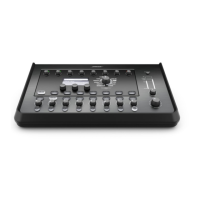Figure 1. T4S Control Panel
(1) INPUT SIGNAL/CLIP LEDs (1–4): Displays the input signal status in color:
Green: Indicates the presence of an input signal
Red: Indicates input source clipping
(2) TRIM CONTROLS (1–4): Adjusts the input sensitivity for the respective channel.
(3) DISPLAY: Provides function menus and system information.
(4) EDITING CONTROLS: These three rotary/push-button controls allow you to select or adjust items/values
appearing on the display.
(5) CH EDIT BUTTONS (1–4): Selects the channel you want to modify.
(6) FX MUTE BUTTONS (1–4): Bypasses the Mod, Delay, and Reverb effects on the selected channel.
(7) VOLUME CONTROLS (1–4): Adjusts the volume level for the respective channel.
(8) MUTE BUTTONS (1–4): Silences the audio output for the respective channel.
(9) MASTER VOLUME CONTROL: Adjusts the overall output level.
(10) HEADPHONE VOLUME CONTROL: Adjusts the volume level of the headphone output.
(11) ROTARY SELECTOR: Allows access to both global and channel-related parameters, which are adjusted
using the editing controls.
(12) PHANTOM POWER SWITCH: Applies +48V power to Input Channels 1–4. A red LED indicates that
phantom power is on.
CAUTION: Set the Master volume control to its minimum position before using the phantom power
switch or powering on/off any microphones that use phantom power.
(13) HEADPHONE JACK: For use with headphones only, with a minimum impedance of 24Ω.
Connection Panel
Figure 2. T4S Connection Panel
(1) POWER SWITCH: Turns the mixer on or off.
(2) USB 2.0 TYPE-B: A USB interface that allows you to connect the mixer to your computer.
(3) USB 2.0 TYPE-A: A USB interface that allows you to stream audio from your flash drive.
(4) ANALOG L/R OUTPUT: Main analog output. Accepts ¼-inch TRS balanced or TS unbalanced cables.
(5) AUX OUTPUT: Two user-definable analog outputs. Can be configured for a pre-fader, post-EQ, and effects, or
post-fader output. Accepts ¼-inch TRS balanced cables.
(6) AUX IN: Analog Input Channels 5/6. Accepts ¼-inch TRS balanced or TS unbalanced cables for line-level
inputs. Can be used for stereo input signals.

